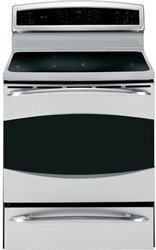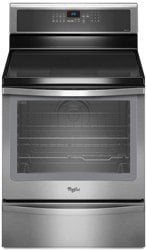GE vs Whirlpool is a comparison between two different companies with two very different marketing philosophies. This comparison might predict where induction may be headed in the future.
GE
For a really big company (number 6 in the world), GE has been an early adopter of technology in appliances. They were the first with induction in the 1980s and quick to the market with induction stoves.
Whirlpool
Whirlpool is the largest American manufacturer, and is the polar opposite of GE. They are always last to market.Since my time at Yale in 1986, they have been last to produce stainless steel appliances, french door refrigerators (OK they were first, but dropped it before my time), pro cooking and even late to front load laundry. Whirlpool is a manufacturing, not marketing company. However, once they identify a trend, they are incredibly cost effective.
Before we compare: Let's define induction and its attributes (you can always read our Induction Buyers Guide)
Induction cooking uses induction heating to directly heat a cooking vessel. Traditional electric or gas cooking uses heat transfer from the electrical coils or burning gas. Induction cookware must be magnetic or placed on a magnetic trivet for induction to work. Induction cooking boils water faster than electric or even gas and also lowers to a simmer instantly. Less ventilation is required, because induction emits less heat than gas or electric. Lastly, induction is safer since it needs to be activated by metal.
While induction cooking is becoming more popular, only a few companies manufacture freestanding induction ranges: Frigidaire, Samsung, Electrolux and now Whirlpool.
GE vs Whirlpool Freestanding Induction Ranges
 |
VS
|
 |
|
GE PHB925STSS Induction Range
- Induction cooktop technology
- PreciseAir(TM) convection system
- Warming drawer
- NextStep controls
- Hidden bake oven interior
- Black gloss oven interior
- $2,459
|
|
Whirlpool WFI910H0AS Induction Range
- AccuBake(R) Temperature Management System
- TimeSavor(TM) Plus True Convection Cooking System
- AquaLift(TM) Self-Clean technology
- Induction cooking technology
- Rapid Preheat
- Industry's largest capacity range available
- EasyView(TM) extra-large oven window
- Split Rack
- Convection Conversion
- Max Capacity recessed rack
- Hidden Bake Element
- Warming Drawer
- $1,624
|
Whirlpool and GE offer very similar features. Both have warming drawers, keeping food warm and moist without drying out. The induction unit offered by GE has five (5) burners, while Whirlpool offers four (4) but the extra GE burner is a warming zone. The most prominent difference between the ranges is the output of the burners.
Burner Output
| |
Whirlpool WFI910H0AS |
GE PHB925STSS |
|
Set 1 QTY
|
1 |
1 |
|
Set 1 Output (W)
|
3,700 |
2,400 |
|
Set 2 QTY
|
1 |
2 |
|
Set 2 Output (W)
|
3,200 |
1,850 |
|
Set 3 QTY
|
2 |
1 |
|
Set 3 Output (W)
|
1,800 |
1,300 |
|
Set 4 QTY
|
- |
1 |
|
Set 4 Output (W)
|
- |
100 |
Whirlpool has much higher wattages on the burners for speed and is also over $800 cheaper. This scenario seems pretty common when an efficient mass manufacturer like Whirlpool (and to a lesser degree Frigidaire) enters a niche market. The early adopters like GE must either lower their prices or lose customers.
Either way, induction will be more affordable at least in the short term.




